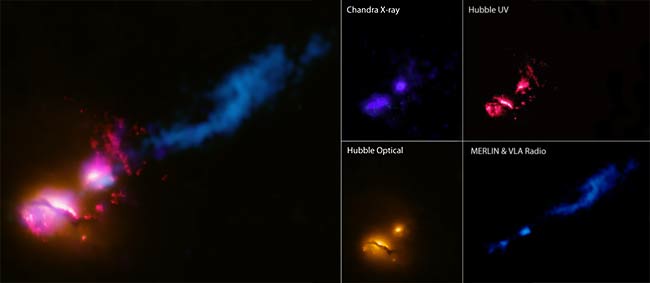Galaxy Blasts Neighbor with Deadly Jet

Thisstory was updated at 1:42 p.m. ET.
For thefirst time astronomers have witnessed a supermassive black hole blasting itsgalactic neighbor with a deadly beam of energy.
The"death star galaxy," as NASA astronomers called it, could obliteratethe atmospheres of planets but also trigger the birth of stars in the wake ofits destructive beam. Fortunately, thecosmic violence is a safe distance from our own neck of the cosmos.
"We'veseen many jets produced by black holes, but this is the first time we've seenone punch into another galaxy like we'reseeing here," said Dan Evans, astronomer at the Harvard-SmithsonianCenter for Astrophysics in Cambridge, Mass. "This jet could be causing allsorts of problems for the smaller galaxy it is pummeling."
Evans andhis colleagues detail their findings in an upcoming issue of the AstrophysicalJournal.
Cosmicdeath
The deadlygalaxy — the largest of two in a system known as 3C321 — is aiming thehigh-energy jet from its center at a smaller galaxy 20,000 light-years awayfrom it, or roughly the distance from Earth to the Milky Way's core. Bothgalaxies are situated about 1.4 billion light-years away from Earth.
Get the Space.com Newsletter
Breaking space news, the latest updates on rocket launches, skywatching events and more!
A brightspot in a NASA composite image reveals that the beam is strikingthe edge of the smaller galaxy, deflecting the spindle of energy intointergalactic space. While not a direct hit, astronomers said the consequencesare frightening.
"Thisis a fascinating result, and we can be glad that we're seeing it from a safedistance," said Neil deGrasse Tyson, an astrophysicist at the American Museum of Natural History in New York who did not contribute to the study."Knowing how lethal the radiation from the jet could be, I wouldn't wantto be anywhere near its line of fire."
Jets from supermassiveblack holes produce tremendous radiation in the form of X-rays, gamma raysand electrons traveling close to the speed of light. Evans said, however, thatthe X-ray and gamma-ray photons would ultimately do the most damage to planets.
"Thephotons can have a really dramatic, profound effect on a planetaryatmosphere," he said. "It's likely the ozone layer on an Earth-likeplanet would be destroyed within months."
Without anozone layer to protect a planet from deadly space radiation, Tyson saidcreatures on a planet's surface would perish quickly.
"Youwould basically render extinct all surface forms of life," Tyson said. "Butit may be that subterranean life is ? immune to this kind of violence in theuniverse."
Recentattack
Theoffending galaxy probably began assaultingits companion about 1 million years ago, which is relatively recent on acosmic time scale. Evans said the unusual event makes 3C321 an important objectfor learning more about the universe.
"We'veseen jets do pretty weird things to their environments, but a head-on collisionis really rare and generates a [large] amount of information about physics thatwe can understand and use," Evans said. "For that galaxy to belooking right down ? the barrel of the gun of that jet is incredibly rare, sothis makes it a really exciting discovery."
Turns outthat the "death ray" may not be all bad news for the victimizedgalaxy, at least theoretically, as such a massive influx of energy andradiation could help form new stars and solar systems by compressing gases.
"Inthe end [3C321] may be the source of new life in that distant galaxy,"said Martin Hardcastle, an astronomer at the University of Hertfordshire, in the United Kingdom. Hardcastle explained that the jet will continue to pourout of its parent supermassive black hole for about 10 to 100 million longer —plenty of time to squeeze otherwise inert gas together into new star systems.
"Jetscan be highly disruptive ? but [create] stellar nurseries," Tyson said. "It'sa fascinating sort of duality about how these high-energy phenomena influencethe environments in which they're embedded."
To fullyview the galactic violence and rebirth, astronomers used NASA's Chandra X-rayobservatory, Hubble and Spitzer space telescopes, and the Very Large Array andMERLIN radio telescopes on Earth.
- See the Video: Death Star Galaxy
- Video: Black Holes: Warping Space and Time
- Journey to the Black Hole
Join our Space Forums to keep talking space on the latest missions, night sky and more! And if you have a news tip, correction or comment, let us know at: community@space.com.
Dave Mosher is currently a public relations executive at AST SpaceMobile, which aims to bring mobile broadband internet access to the half of humanity that currently lacks it. Before joining AST SpaceMobile, he was a senior correspondent at Insider and the online director at Popular Science. He has written for several news outlets in addition to Live Science and Space.com, including: Wired.com, National Geographic News, Scientific American, Simons Foundation and Discover Magazine.









